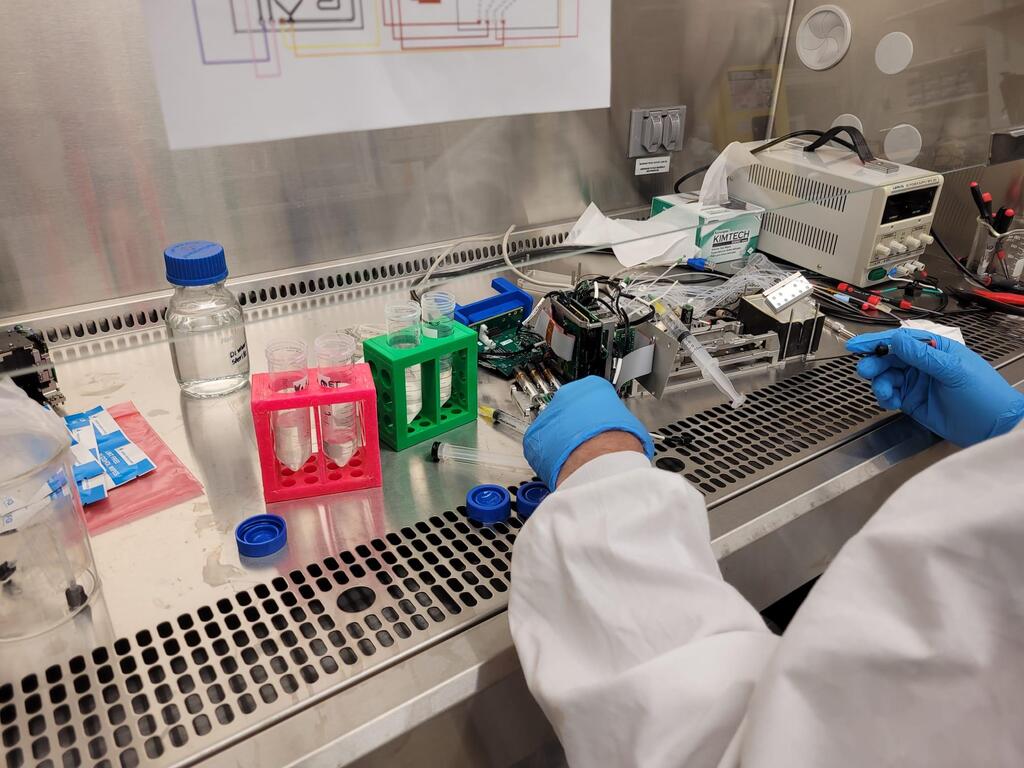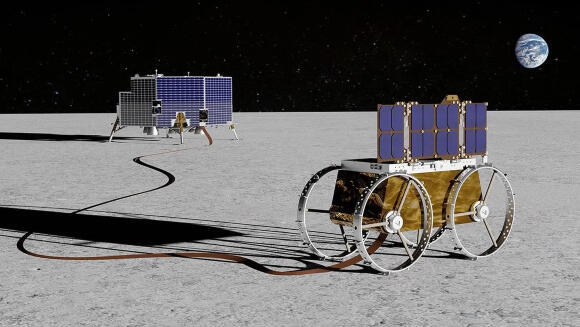Nuclear spaceflight
The idea of using nuclear energy to propel rockets and spacecraft was conceived long before the space age began, in the early days of the nuclear age. While several projects that began during that period reached advanced planning stages, and experiments were even conducted with nuclear rocket engines on Earth, they were all eventually abandoned due to political, state, military, and safety considerations, and none reached testing in space.
Read more:
This week however, nuclear rockets achieved a significant milestone, with the announcement that American aerospace giant Lockheed Martin has been selected to develop the experimental spacecraft DRACO, for the Defense Advanced Research Projects Agency (DARPA), and the US Space Agency (NASA).
2 View gallery


Could a shoebox-sized lab pave the way to a billion-dollar market? SpacePharma's experimental lab during its final pre-launch tests
(Photo: SpacePharma)
In January of this year, the two agencies signed an agreement to develop the spacecraft, and have now selected the contractor that will actualize it. The first trial, according to the current plan, is scheduled to take place in 2025 or 2026. According to the plan, Lockheed Martin will construct the spacecraft itself, while BWX Technologies will develop the nuclear core that will supply the energy for propulsion.
A nuclear thermal engine uses nuclear energy to heat fuel – usually liquid hydrogen – to an extremely high temperature. The expulsion of the gas resulting from this process propels the spacecraft, enabling it to achieve significantly higher speeds compared to regular chemical propulsion. A notable advantage of nuclear thermal engines is their reduced fuel consumption since they do not require an oxidizer. For example, the main stage of NASA's giant SLS rocket, designed to transport astronauts to the moon, carries about 2.8 million liters of fuel; over a quarter of this, approximately 740 thousand liters, is liquid oxygen. By eliminating the need for an oxidizer, the engine can accommodate much more fuel, ultimately extending its operational duration.
In the DRACO experiment, the rocket will not be activated during launch, but only far from Earth, after a conventional rocket launch by the US Space Force. The core will use HALEU (High Assay Low Enriched Uranium) nuclear fuel, which is considered safer and reduces the environmental risk in case the rocket crashes or explodes before reaching space.
“Nuclear-Thermal Propulsion (NTP) achieves high thrust similar to in-space chemical propulsion but is two-to-three times more efficient," said Tabitha Dodson, the DRACO program manager, in an agency press release. With a successful demonstration, we could significantly advance humanity’s means for going faster and farther in space and pave the way for the future deployment of all fission-based nuclear space technologies.
"These more powerful and efficient nuclear-thermal propulsion systems can provide faster transit times between destinations. Reducing transit time is vital for human missions to Mars to limit a crew’s exposure to radiation” said Kirk Shireman, vice-president of Lunar Exploration Campaigns at Lockheed Martin. “This is a prime technology that can be used to transport humans and materials to the Moon. A safe, reusable nuclear tug spacecraft would revolutionize cislunar operations. With more speed, agility and maneuverability, nuclear thermal propulsion also has many national security applications for cislunar space.”
Israeli medicine from space
The Israeli company SpacePharma is set to launch an experiment on the International Space Station this week, with the goal of testing the feasibility of producing in microgravity a protein that could potentially prevent or slow the development of prion diseases. These are conditions characterized by brain function deterioration due to a defect in the functioning of certain proteins that improperly fold into an incorrect three-dimensional structure (misfold). Through a mechanism that is not yet fully understood, this misfolding defect is transmitted between proteins, causing the spread of the disease in the brain. The most widely known prion disease is Creutzfeldt-Jakob Disease (CJD), a fatal condition resulting in progressive degeneration of the brain.
Recently, researchers from Italy and Spain developed a way to slow down the misfolding of proteins, using another protein combined with an additional molecule, which binds to the prion and stops the misfolding process. Upon this, the cell's cleaning systems eventually eliminate the defective protein and prevent the prion from infecting other proteins. The researchers calculated the structure of the therapeutic protein using computer programs that model protein folding data using artificial intelligence technologies. However, a major obstacle has been the inability to crystallize the produced protein, hindering further study of the protein and its experimental use.
Researchers at SpacePharma, along with their partners in Europe and Israel, including the Creutzfeldt-Jakob Disease Foundation, hope that microgravity conditions aboard the space station will facilitate protein crystallization. The experiment will be conducted in the company's standalone laboratory, which is a 3.4-kilogram sealed box equipped with systems that allow remote operation from Earth. Various conditions for crystallizing the protein will be tested in the experiment, with the hope of obtaining a solid protein and testing its suitability for treating prion diseases, albeit only in laboratory settings at this point.
The lab will be launched to the space station on board the unmanned supply mission NG-19, scheduled for launch via an Antares rocket on August 1. Once the onboard crew connects the mobile lab to the station's electrical and communication systems, the experiments will be conducted remotely from Earth for approximately three weeks. The lab will subsequently be returned to Earth aboard a SpaceX Dragon spacecraft, which will also carry the astronaut team completing their space mission.
"If the protein crystallization experiment in space is successful, it will pave the way for novel technologies that have not yet been explored," SpacePharma CEO and founder Yossi Yamin told the Davidson Institute website. "If we can produce medications in space that can treat degenerative brain diseases, such as prion diseases, or amyloid diseases like Alzheimer's, it would open a market worth billions of dollars annually."
Electricity on the Moon
The United States Space Agency has awarded development grants totaling 150 million dollars to companies or groups developing technologies for lunar energy production, among other initiatives. Nearly a quarter of this total funding, approximately 35 million dollars, was awarded to Astrobotic Technology, which is developing a solar power-based electricity production system for the moon. The funding is intended to support the development of small autonomous vehicles, about the size of a shoebox, designed to lay a kilometer-long electrical cable to connect the lander that is equipped with solar panels, to be brought to the moon, with the spacecraft that have landed nearby on the lunar surface. Even the small vehicle, named "CubeRover," will draw its power supply from the solar panels.
Blue Origin also received a similar funding amount to develop solar panels using materials extracted from lunar soil.
Another group, led by Zeno Power, won a 15 million dollar grant to develop a system that generates electricity from radioisotopes. Such a system will be independent of solar energy and will enable missions on the moon to continue functioning even during the lunar night, which lasts approximately 14 Earth days.
Among other technologies, ULA won a 25 million dollar grant to continue developing its inflatable heat shield, which is also designed to serve as a brake and slow down spacecraft as they enter Earth's atmosphere, or that of other planets. In total, the space agency awarded 11 grants for initiatives aimed at supporting national space and lunar missions, as well as private enterprises.
The aliens have arrived at Congress
The debate over whether extraterrestrials have visited Earth and perhaps even left us secret technologies has reached the U.S. Congress in Washington this week. The House of Representatives Subcommittee on National Security convened for a hearing titled "Unidentified Anomalous Phenomena: Implications on National Security, Public Safety, and Government Transparency."
2 View gallery


On the moon, even a seemingly trivial task such as laying an electrical cable can be challenging. The tiny vehicle that designed to connect the customers to the charging supply
(Simulation: Astrobotic)
During the hearing, the committee members heard the testimony of three witnesses: David Grusch, a former Pentagon intelligence officer, who claims that the United States is concealing information about government programs that hold alien artifacts, and are deploying technologies reverse-engineered from crashed extraterrestrial vehicles; David Fravor, a former US Navy combat pilot, who claims to have encountered aliens several times, including during the Tic Tac incident in 2004, the footage of which continues to spark controversy; and Ryan Graves, also a former U.S. Navy combat pilot and current executive director of "Americans for Safe Aerospace", a non-profit organization seeking to disclose alien encounters.
Grusch, the first witness, restated previous claims, including that he has information about a secret program to collect debris from crashed alien spacecraft and reverse-engineer their technologies. While Grusch admitted he had not personally witnessed such events or scenes, he insisted that he had heard evidence from individuals who were present at these occurrences and who hold filmed footage and documents. When specifically asked if he had encountered filmed footage of such crash sites, Grusch said he could not discuss it in an open, unclassified meeting. He also suggested the existence of secret space technology programs operating outside the oversight of Congress.
Graves told the committee that pilots' sightings of unidentified anomalies are significantly underreported. "These sightings are not rare or isolated. They are routine,” Graves said. "Military aircrew and commercial pilots — trained observers whose lives depend on accurate identification — are frequently witnessing these phenomena." According to him, many pilots are afraid to report these incidents for fear of stigmatization or even job loss. He warned that ultimately, such stigmatization jeopardizes national security.
Fravor expressed concern about the government's failure to acknowledge everything that has to do with processing and assimilating technologies from other worlds. "The 'Tic Tac object' we engaged in 2004 was far superior to anything that we had at the time, have today, or [are] looking to develop in the next 10 years," Fravor said. "If we in fact have programs that possess this technology, it'd be nice to have oversight from those people that the citizens of this great country elected in office to represent what is best for the United States, and best for the citizens. "He expressed concern that the alien technology, which he claims is in the state's hands, could compromise United States security.
At the end of the discussion, no new information was revealed, and no arguments were presented that had not been heard before. As previously reported, no evidence has been found of extraterrestrial visits to Earth in any of the documented reports that the special committee on the subject has reviewed to date. The only novelty lies in the fact that this discussion took place within a House of Representatives committee. Several committee members even emphasized in their summary that for them, the core of the issue is not the question of the existence of evidence concerning visits by extraterrestrial beings from other worlds, but rather the need for responsible and transparent government conduct.

